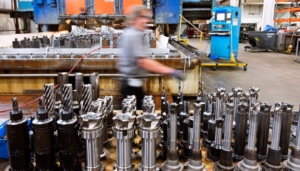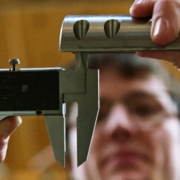Space holds promise for small manufacturers, but modeling success is proving as challenging as the missions
Here’s how Primes and the companies that fly can make life easier for suppliers
If “Prime” contractors like SpaceX and Lockheed Martin, along with companies like lunar explorer Ultimate Machines, are the public face of America’s new space economy, contract manufacturers and other suppliers to the industry are the glue. Their parts comprise the systems that fly. Without them, without an industrial base of suppliers, there is no burgeoning space industry.
But in key areas — like national defense — it’s an industrial base already in crisis. The National Defense Logistics Agency (NDIA) estimates that the defense industrial base has declined by over 40 percent in the last decade — over 17,000 small businesses in the past five years alone.
There’s no mystery as to why. Government contracting — Department of Defense contracting — is notoriously hard. Fewer entrepreneurs are launching manufacturing companies. And for a new generation of business leaders passionate about manufacturing, other opportunities beckon.
Including space.
But the “space base” is already showing signs of strain. Turns out that space procurement is its own animal. Volumes are lower than traditional aerospace contracts — orders are smaller. Money is also tighter — there’s more upstart commercial work. Turnaround times are truncated. Uncertainty is the rule.
Even its most successful operators are wary. Hernan Ricaurte, principle of Ricaurte Precision Inc. (RPI) and a growing supplier to the space industry, told me, “Working with space companies requires us to be agile given the NPI (new product introduction) to production requirements and tight schedules. It’s an industry,” Ricaurte says, “that’s not for the faint of heart.”
Justin Quinn’s Focused on Machining was an early entry, perched within Colorado’s space-friendly Front Range. “I mean, for a shop like ours, capacity is always the issue.
But it’s not with this type of business. It’s not long-term capacity. In fact, they don’t want to know what you’re doing two months from now. They want to know what you’re doing in the next two weeks,” he laughs. “Parts manufacturing isn’t a two-week proposition. So, that’s where we see the hang up now,” Quinn adds, ” there’s just not a lot of time to react.”

Quinn’s persevering, as is Mike Sneddon, CEO of SG Aerospace and also a space-industry supplier with clear-eyed views of the ecosystem. I asked Sneddon how he’d launch a contract space manufacturer today. “The only thing you would do is consider it a secondary business or a subsidiary of a current company,” he says. “There’s just no way that you could sustain these [company] conditions in any type of a business model, at least in a business that lasts.”
Sneddon speaks from an enviable position. SG Aerospace was invited to be a supplier to Artemis — NASA’s ambitious program to land the first woman and first person of color on the Moon, explore the lunar surface, and lay the groundwork for sending astronauts to Mars. SG has unique talents. “We do a lot of titanium and stainless — hard metals,” Sneddon says, “that kind of gets us in the door.”
Space is a means to an end for Sneddon, where it’s less than 5 percent of his current business. “Space is by far the hardest. We were trying to use space as a stepping stone into different opportunities, to be able to say ‘Hey, we’ve tackled space, and we’re good at it.'” His Artemis work should validate his approach.
All of this to say that the space industry would do well to avoid the pitfalls that plague procurement in defense-related aerospace and aviation, to attract, not repel, the quality suppliers it needs. Both Quinn and Sneddon have suggestions.
“I think SpaceX has kind of hurt the industry a little bit, as they have this ‘I need everything tomorrow’ kind of mentality,” Quinn says. “It’s becoming the kind of industry that if you say, ‘I can’t get to that right now,’ they won’t hesitate to go down the road and find someone that can. I’m not sure that’s in the industry’s best interest.”
Sneddon sees it similarly. “We understand the need to do good, solid work, and demonstrate we’re passionate about the industry,” he says. “But once you’re in, and you’ve proved yourself, the primes need to [provide some certainty], to establish a time frame and say, ‘OK, give us everything you have for two years, and we’ll set aside work to keep you guys busy and successful.
“It’s already happening with some government contracting, where specific contracts set aside work to keep suppliers engaged and motivated — but still required to meet their commitments,” Sneddon adds. “It’s not a freebie. Just make sure you support suppliers while we make space work for us. Or else many will go under.”
Space missions are hard enough. But in the industry’s rush to be first, highest, and farthest, once again, the uber-important industrial base is now vulnerable. Those that fly, and grab the headlines, would do well to ensure the “space base” prospers.
Bart Taylor is a BDE with Moss Adams and founder and former publisher of CompanyWeek manufacturing media. Reach him at bart.taylor@mossadams.com.



